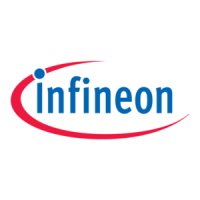• Program Security Data – Allows programming security regions if the target device supports this capability.
For example, for PSoC™ 61 PSoC™ 62, and PSoC™ 63 MCUs, this option enables programming the eFuse
region.
• Target AP – Allows you to select the target access port (DAP) that will be used for programming. Possible
values include: CM0, CM4, and SYS_AP. This option is available only for PSoC™ 64 MCUs.
• Flash Size Limit – Limits the size of application flash available for programming operations. This option is
available only for PSoC™ 64 MCUs.
• Programming Mode – Use this option to define programming mode for PMG1 devices. The mode options
include:
• Reset - this programming mode enables acquisition of the target device in the Test mode.
• PowerCycle - In this mode the programmer cycles power to acquire the device.
4.2.4.2 Probe Settings
The Probe settings allow you to configure the programming and target device before you connect to it. These
settings are available when CYP is not connected to the device.
• Interface – To select the hardware (debug) interface for communication with the target device. The
possible values include: SWD and JTAG if supported by the device.
• JTAG Chain – To select the interested target device in the JTAG chain. This option is only available for
probes supporting JTAG interface. See Program PSoC™ 6 MCU in JTAG Chain for details.
• Voltage (V) –To select the power supply voltage of the target device in Volts. This option is available only if
the selected probe has the power control capability.
• Clock (KHz) – To select the frequency of the hardware interface in KHz. This option is available only if the
selected probe supports configurable frequencies.
• Reset Type – Specifies the type of the Reset Chip operation. The possible values include: Soft and XRES:
• Soft is a software reset type that sends the system reset request to the ARM core.
• XRES is a hardware reset type that toggles the XRES hardware line.
• Sflash Restrictions – Specifies the Sflash programming behavior for PSoC™ 6 MCUs. This option is available
only for PSoC™ 61/62/63 MCUs. The possible values include:
• Erase/Program of Sflash is prohibited.
• Erase and Program of USER/TOC/KEY is allowed.
• Erase of USER/TOC/KEY and Program of USER/TOC/KEY/NAR is allowed.
• Erase and Program of entire Sflash is allowed.

